Boy, did I luck out with this one. I spent Saturday night prepping a container full of rocket in the hope that the weather would cooperate Sunday morning. I figured most baseball/softball practices would be on hiatus in favor of Easter egg hunts, so I wasn't surprised to find the field empty when I arrived just before noon. I set up near 60's pitcher's mound, found another key that didn't fit, tore down when it looked like I might have to go home for my launch key, then found it in my console.
Speaking of which, the CMR Effy would be flight #1 on the day. (The FRW Vector G was first on the pad but was pulled due to a failed igniter.) The Effy was part of one of my favorite eBay lot wins, one that also netted me an FSI Dart and Estes X-Wing with a "missing pincher". They had belonged to a New York science teacher who put his name and address on all of his rockets, so I felt good keeping them flying. Like me, he was apparently a fan of fluorescent orange paint.
The Effy flight would be on a 1/2 A6-2. Like the Canaroc Tornado Two last week it's supposed to be a spin stabilized bird. Also like the Tornado Two I couldn't tell you if it spun or not. I had the rod adjusted for the slight breeze and the Effy flew surprisingly straight off the pad. Altitude was excellent for the 1/2A, topping out at 193'. After ejection it streamed back to the field and landed without incident just to my left. It was an excellent start.
With the wind test out of the way, I reloaded the Vector G Goony. This was a long-ago project during my losing battle with Goony Fever. It tends to incur damage with every flight because the bottom tube is actually a rolled pizza mailer printed on shiny paper, which makes it unable to hold the fins. It looks like hell but keeps on flying.
The G would be a B6-4 flight, one of several I thought I had packed on the day. I couldn't have done this any better. The G cleared the rod with a slight lean to the left to the edge of Woodfill Avenue. It topped out at 273' and the orphaned red chute that I'd discovered in the shop Saturday night popped immediately. The recovery was almost straight down with only a slight bit of drift back to the right, with a landing in left center field.
This would be a B4-4 flight, a detail that confused me because I saw the yellow plug and just figured "A8-3". In my defense, I loaded this two launches ago, and it came home unflown. (As did most of the rockets I took to the field that day.) Expecting a low level A flight, I was surprised when it took off with a noticeable kick and respectable altitude. It topped out at 264' and ejected as it tipped over, floating back on the same mystery chute that brought the Vector G back.
Flight #4 would be the freshly finished Semroc Oso, and when I say freshly finished, I mean yesterday. This wasn't an actual Semroc kit, but a collection of parts that I bought from eRockets, so in my mind it counts. It turned out surprisingly nice and was one of the rockets I brought to the field last weekend, but in primer. I much prefer the finished look.
The flight was as expected, fairly high for the field at 302' and slightly left of the pad. Ejection appeared to occur at apogee, and I waited for the chute, but it never came. I had used the same chute as I had for the Vector G and Plasma Probe, so I expected similar performance with the Oso, but it came in hot with no sign at all of a red chute. Confused, I approached the crash site and as I got closer to it I noticed something red in the grass about ten feet from the rocket. It was the parachute. Still prepped as I had prepped it, but with bare strings where the snap swivel had been. I found the snap swivel still clipped to the nose cone. Apparently, the knot had untied during the flight, but it still managed to keep pace with the Oso as it fell. I felt like I was living lucky. Not as lucky as the red parachute, but not bad.
Next up was an Estes Alpha that should see a lot more airtime here at B6-4 Field than it does. I'm not sure what the issue is, but I seem to have Alpha decals popping up in every random spot in my shop. There was apparently a time when I was buying Alphas as parts donors for other projects. I don't remember this, but the decals don't lie. As it is, this is the only Alpha I've ever built that used the actual kit decals. It's almost too shiny.
The Alpha would provide my pucker flight of the day. It was an A8-3 flight, perfectly reasonable for conditions. I loaded the red parachute in it because it was apparently lucky. Most of the flights on the day had leaned to the left off the pad and recovered right out from me near the center of the field. Not this one. The Alpha went straight out from me off the pad, climbing to 302' before uncorking in deep center field. The breeze was apparently strong over there and it immediately began racing toward right field. Right field is sloppy and mucky at this time of year, but that's not a big issue. The softball fence is twenty feet off the foul line, and the fence looked to be in play. At one point the Alpha looked to catch a thermal. Just what I needed. I lucked out and the thermal found someone else to torment and the Alpha landed safely in the muck.
Next victim would be the Estes Solar Probe, a vintage kit I bought from Penn Valley Hobby via eBay many years ago. As you can see, it's had a hard life. I was flying one Saturday and a local kid heard me from his back yard. William was an excitable fourth grader and to him, not much ramped up the excitement like rockets flying in his back yard. He dragged his Mom down and I let him press the button for me, but after one particularly impressive flight, he charged out to recover the rocket, in the process charging over my custom rocket tote (a copy paper box I got at work.) William wound up on his face amidst the wreckage of a half dozen of my fleet. He turned and looked at me with a stricken look on his face. His Mom was likewise mortified. They were both shocked to see me laughing. It was so ridiculous that I couldn't help but laugh. As far as I remember, everything was fixable, and William moved a few weeks later. I still get a laugh thinking about his buffalo charge over the fleet. The Solar Probe was one of the more heavily damaged rockets, but like I said, fixable.
My long-suffering Estes Screamer was next on the pad, flying on a 1/4A for the first time since 2014. In my defense, I flew two other Screamers here in that time and actually got one back.
A 1/4A is about all this field can handle in a BT-5 model, well, if you want it back. I've recently bought a large collection of BP motors and a bunch of 1/4A motors were included, so I'm good for BT-5 birds here for a while. The Screamer flight was dead straight, and being that I opted for nose blow recovery, was up and down quickly. I've only had the decals for this one for a decade plus, so maybe this is my year.
Flight #8 would be handled by the Semroc Tau Zero, a prototype version that Jay Goemmer sent me as a shakedown build 20 years or so back. I think the idea was if I could get it flying, it would be idiot proof. Somehow I managed not to kill it. It's flown here quite a bit through the years along with two other TZR rockets, the Prometheus and Scram Jet upscale.
This was an oddly short A8-3 flight. It travelled largely straight off the pad to 224', but just as it seemed to be getting going, the ejection charge fired. It sounded like a truck backfired, and the rocket fell back to the field via streamer like a wounded duck. Post-flight inspection showed no damage despite the violence of the ejection charge.
Next up on the pad would be my mysterious Wizard, the mystery being how it came to be unflown several years after it was built and finished. Actually, it's not much of a mystery. I have more Wizards than I can keep track of. This one I felt compelled to build because it was in the 80's packaging and just a step away from my original first year version.
The flight was a typical Wizard, straight off the pad and with impressive altitude, even on the A motor. It drifted away from the pad over center field and when the ejection charge fired the rocket dropped quickly on the streamer to the same no-man's land behind shortstop that the Solar Probe found earlier. I now have no unflown Wizards.
20 years ago I drove up to B6-4 Field for an early evening launch before we moved into the neighborhood behind the Field. I'd picked up an Estes Solar Sailer II via eBay, built it and painted it, then found the vintage decals to be a bit too vintage. They came off the paper in chunks despite my unleashing all the tricks I knew at that time relative to decal bonding. Undaunted, I took the SSII to the field that night and left with it decorating one of the trees on the hill. That wasn't my only tragedy on the night as my Semroc Taurus was blown in half by a shotgun ejection charge. I found another SSII on eBay a few years later, and this would be the first flight.
I'm not sure why I chose an A8-3 for this rocket. Maybe I was haunted by that B flight 20 years ago that cost me my first SSII. Whatever the case, I was expecting a B4-4 flight like the Solar Probe, but that was not the case. The flight was respectable, but an early ejection charge like the Tau Zero cost it quite a bit of altitude at the tail end of the flight. Everything happened fast and the chute remained wadded on descent. The rocket landed without damage just to my right in foul territory off the third base line.
The next flight made the day a success no matter what happened with the other flights. This was my original AMROCS Wombat clone, not to be confused with the AMROCS Wombat clone I flew here last week. This one had been damaged on one of the flights in Huber Heights in 2018 and the chunk of the fin that was knocked off was never found. A few weeks ago I found it in my shop, blew the dust off, and spent a Saturday trying to repair the fin just enough to get it airworthy again. It didn't look perfect, but that was never what I was after.
This would be another 1/2A6-2 flight, which I've come to like as my first flight glider motor here at B6-4 Field. Things looked grim at liftoff. The Wombat did a big turn to the right. Lots of trouble in that direction; US 27, the baseball backstop, the softball complex. It was heading for the road when the ejection charge fired. That was when the flight transformed. It did an immediate 180 and began a straight, stable glide across the field from home plate to deep center field. No way to say it but beautiful. It never got above 100' during the glide, then petered out in deepest center and flew to the ground. It makes me want to take it back to Huber Heights to see what other motors might be worth trying on a larger field.
The Lamprey flight was not without a little drama of its own. It was a B6-4 flight, so the altitude was decent, but unlike the Wombat, it left the pad leaning left toward Woodfill Avenue. I struggled to keep the flight in sight, especially when it popped the chute and began the recovery drift right back through the sun. I knew it was coming, so I got my eyes closed and kept moving the camera, hoping to catch something of the recovery on screen. To my great surprise, I opened my eyes to find the Lamprey right on my screen and I was able to follow it to touchdown, which happened 20 feet from the pad.
I had more birds in the box, but the breezes were becoming more insistent, and the next flight would have been #13, so I opted to not press my luck. Two of the rockets that made the trip and got to the pad, only to have issues that kept them from flying were the Quest Q-EZ glider and the Apogee Centrix, which I had hoped to fly on one of the Apogee 10.5mm motors. The Q-EZ glider would have required a standoff that I hadn't brought along. The Centrix made it to the pad, had the leads hooked up and the button was punched, but nothing happened. Apparently, the motors need to have something to scrape the inner surface of the motor to better expose the propellant. That and my first attempt at working with the tiny igniters likely combined to make things less than successful. Sunday is just two days from now, and things look promising for another launch, so I'm hoping to have better news this weekend.









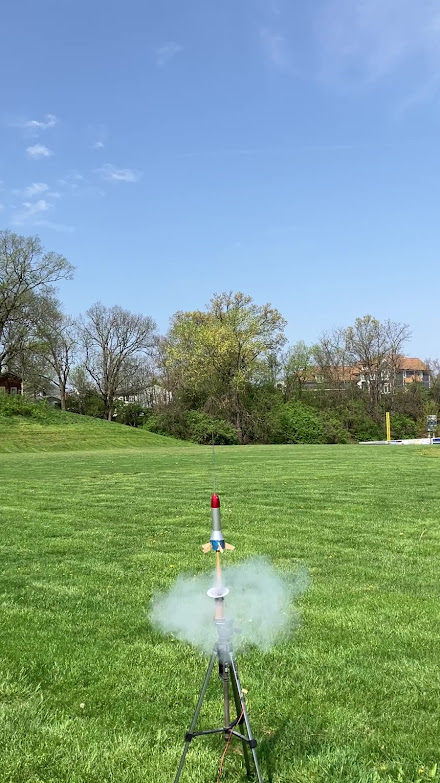















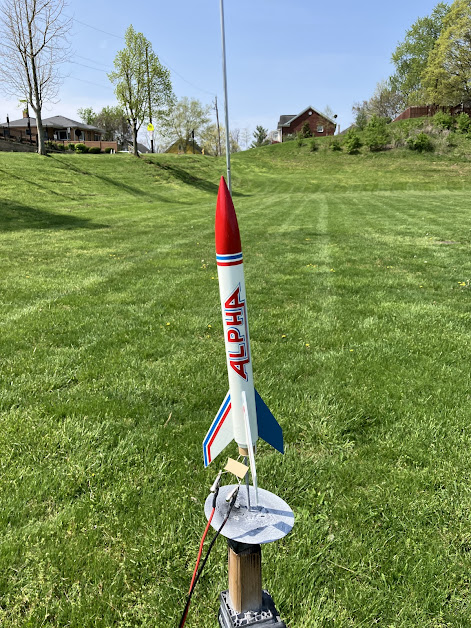



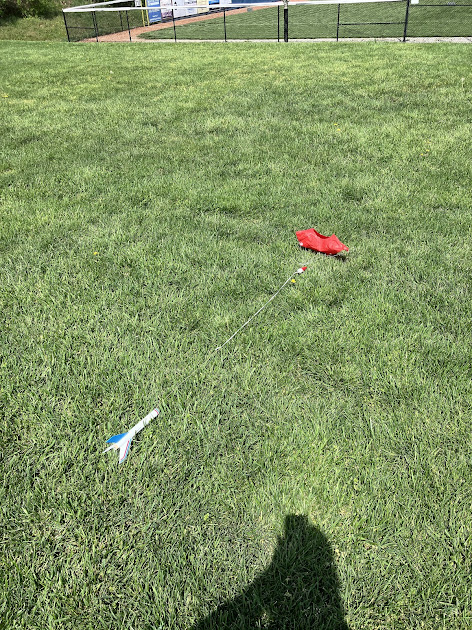
















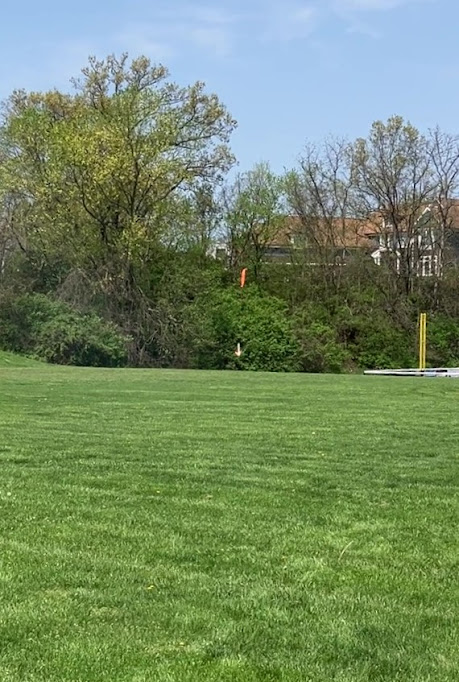

















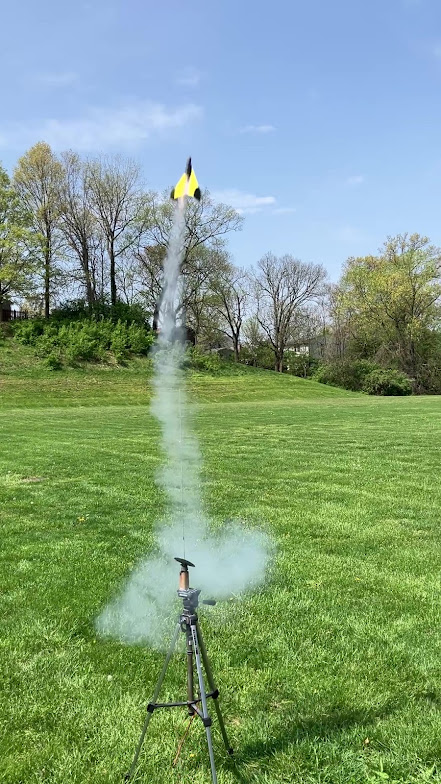















That was a pretty big launch! We had your weather the day before — beautiful here on the 19th. I managed to get seven in the air. I had MY new Solar Sailer II almost ready but I didn’t have time to finish tying up the chute so skipped it. I’ll post some pics on MeWe.
ReplyDeleteThis wasn't all for me. They had a retired guys launch on Wednesday, which will likely be my one and only trip to the corn this year. It was beautiful, but I overdressed and overheated. Rookie mistake? I got five flights in and got to see a perfect Estes Tomcat glider flight, so I considered it a winner even though I didn't get to fly all I'd planned to fly. I've got another box of birds ready to go if Sunday comes through for me again, but tonight we're really getting hosed.
DeleteTry using an Estes igniter next time you try to fly your Centrix. I have used Estes igniters in the Apogee Micro motors since the late 1990's. I have had zero luck with the supplied igniters.
ReplyDeleteI was wondering about that yesterday as I was trying to find something thin enough to fit into the nozzle so I could scrape away any clay and expose the propellant. Thanks for the advice. Now I'm fired up again.
DeleteThis comment has been removed by the author.
ReplyDelete